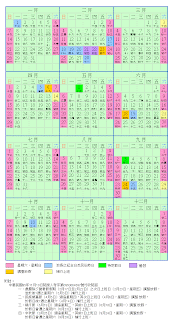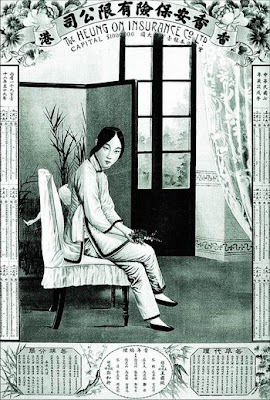According to Wired News, February 24th marked the 425th anniversary of the Papal Bull institutionalizing the Gregorian Calendar (is that the Gregorian 24th or the Julian 24th?). And in an epic story involving missionaries, Ming, Manchus, merchants, modernizers and hot mamas, it reached China 340 years later. While this might sound awful long, they beat Russia by six years, when the Council of People’s Commissars declared that January 31st would be followed by Valentine’s Day, February 14th. And besides, what’s so great about Pope Gregory?
 China did not officially adopt the Gregorian calendar until January 1, 1912, with the founding of the Republic of China, and disposed of traditional Chinese lunar dates. It did not, however, catch on immediately. As Henrietta Hudson points out in her book The Making of the Republican Citizen: Political Ceremonies and Symbols in China, 1911-1929, “Since the government had lost the monopoly the Qing Dynasty had to some extent maintained over the production of almanacs, private publishers suited everyone’s convenience by providing almanacs which listed lunar equivalents of the solar dates and other useful information. Interestingly it seems to have been common for privately published almanacs illegally to claim official authorization.” As a result the government issued a calendar incorporating both in 1914. Use of the Gregorian calendar was a public marker of both political and social revolution, along with such other radical changes such as suits, hats, trousers, skirts, leather shoes bowing to greet someone and polite women appearing in public spaces. The ROC calendar labeled 1912 the Year 1, and continues to be used in Taiwan where it is currently the Year 96, despite pressure last year to abandon it.
China did not officially adopt the Gregorian calendar until January 1, 1912, with the founding of the Republic of China, and disposed of traditional Chinese lunar dates. It did not, however, catch on immediately. As Henrietta Hudson points out in her book The Making of the Republican Citizen: Political Ceremonies and Symbols in China, 1911-1929, “Since the government had lost the monopoly the Qing Dynasty had to some extent maintained over the production of almanacs, private publishers suited everyone’s convenience by providing almanacs which listed lunar equivalents of the solar dates and other useful information. Interestingly it seems to have been common for privately published almanacs illegally to claim official authorization.” As a result the government issued a calendar incorporating both in 1914. Use of the Gregorian calendar was a public marker of both political and social revolution, along with such other radical changes such as suits, hats, trousers, skirts, leather shoes bowing to greet someone and polite women appearing in public spaces. The ROC calendar labeled 1912 the Year 1, and continues to be used in Taiwan where it is currently the Year 96, despite pressure last year to abandon it.
Nothing quite says it all like the Republican era “Shanghai Calendar Girls”, or 月份牌 (yuefenpai). Commissioned often by foreign companies, particularly cigarette manufacturers, and drawn by local Chinese artists, yuefenpai are still strongly associated with Chinese women and Shanghai in particular. Grand pianos, European furniture, sexy women and quite often no calendar (who cares what day it is?), the yuefenpai were the clash of civilizations made into a pin-up.

 Some of the more discreet Calendar Girls. The one on the left is from 1918, while the one on the right is not clearly dated. Note the background, hairstyle, and jewelry. This is a modern lady. On the left, too; she’s wearing pants.
Some of the more discreet Calendar Girls. The one on the left is from 1918, while the one on the right is not clearly dated. Note the background, hairstyle, and jewelry. This is a modern lady. On the left, too; she’s wearing pants.
Then there were the other calendar girls. The ones with no calendars. You can view some racier ones here (naughty nude 狐狸精, not quite work-safe), but I like this one for the Art Deco meets Qing look:
 The yuefenpai style was later appropriated to some extent by the Communist Party, and taken even farther from being calendars (see Stefan Landsberger’s Iron Women, Foxy Ladies). After using the female image to sell the revolution, it eventually came back full circle when Jin Meisheng, who had painted yuefenpai since 1920 (and did this particularly naughty one involving a dog), published a new (conservative) one in 1989 after decades of painting women revolutionaries.
The yuefenpai style was later appropriated to some extent by the Communist Party, and taken even farther from being calendars (see Stefan Landsberger’s Iron Women, Foxy Ladies). After using the female image to sell the revolution, it eventually came back full circle when Jin Meisheng, who had painted yuefenpai since 1920 (and did this particularly naughty one involving a dog), published a new (conservative) one in 1989 after decades of painting women revolutionaries.
Stayed tuned for Part Two: Is That an Armillary Sphere In Your Robe or Are You Just Happy to See Me?
Interesting stuff. That pic with Lassie was pretty racy for sure.
Kinda reminds me of that picture you always see in bathrooms of the chick with the water jug.
Good luck with the site! Looking great so far. 🙂
Great post, Dave.
“European furniture, sexy women and quite often no calendar (who cares what day it is?), the yuefenpai were the clash of civilizations made into a pin-up.”
This clash of civilizations also reminds me of the odd juxtaposition of images you would find on New Years Prints (nianhua) from the 1980s and 1990s. The use of specifically “Western” images really forces one to think about just how ‘modernity’ was defined by Shanghainese of this period.